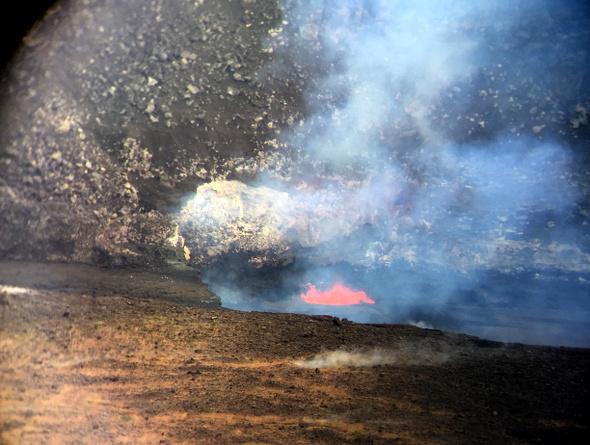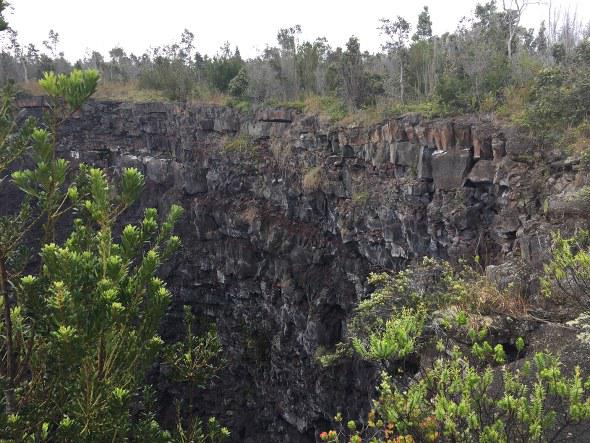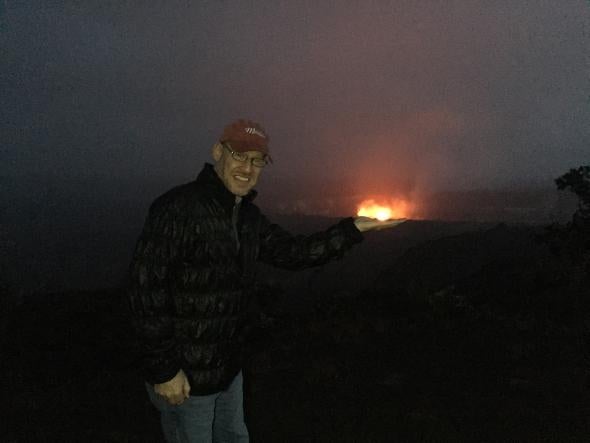Our world is extraordinary.
Of all the planets, ours alone has a surface driven by tectonics*. Under the relatively thin crust lies a layer of incredibly hot rock under unimaginable pressures. The physics of this material is so bizarre and so extreme that solid rock can behave in some ways like a liquid, with hot material rising and cooler stuff sinking… though it only creeps along at something like two centimeters per year.
But move it does, driven by the heat of the Earth’s core below it, powered itself by four sources: radioactive decay, leftover heat from the planet’s formation billions of years ago, heavier material sinking down to the core, and the squeeze of gravity on all of this. As the hot material of the mantle slowly convects upward, it can punch through the thin solid crust of our planet, forming volcanoes.
I’ve visited many volcanoes in my years, including the monstrous Kilauea on the Big Island of Hawaii. Twice before I’ve stood near the rim of the crater Halema’u’ma’u, watching the plume of sulfur dioxide blowing up from a lava pool down deep in the throat of the vent. But I’ve never seen the lava itself… until just the other day.

Phil Plait
That photo shows the view from the Jagger Museum, located roughly two kilometers from the vent (you can see a live web cam on the Hawaii Volcano Observatory page). I used binoculars to magnify the shot, and you can see the glowing lava clearly. Usually the surface of the lava lake is too far down the vent to see, but for the past few days pressure from below has driven it up to just below the rim. It’s a little hard to tell, but the yellow layer of rock is the rim, stained by sulfur fumes. The lava lake is about 15 meters below it, and the lava you can see in the shot was fountaining up as high as the rim itself.
I stood in awe watching this. That’s liquid rock, far denser than water, hundreds and thousands of tons of it launched into the air as gases from below drove it skyward. The forces below our feet are immense.
The volcano is littered with ancient lava flows, active steam vents (water from rain seeps down into the rock, gets heated by the magma below, and blasts back up as steam; standing in it feels like the Earth itself is exhaling on you), and in some cases dead pit craters, like Devil’s Throat:

Phil Plait
This probably started as a cavern, but the walls collapsed, widening it and creating sheer vertical cliffs. It’s about 50 meters across and the same deep. It’s not a perfect circle, but the curve to the wall is obvious, as is the layering. That’s not sedimentary layering like you’d see in the American southwest; no such thing has happened on the Big Island. In this case, the layering is from dozens, hundreds of volcanic eruptions, each sending lava coursing away from the volcano. Everywhere you go on Hawaii you can see this same sort of thing.
It’s a stark reminder that the entire island is a gigantic volcano. Five of them, actually (Kilauea, Mauna Loa, Mauna Kea, Kohala, and Hualālai). Lava flows crisscross each other, some dark —these are generally fresher, only decades old— and some brown or redder, oxidized as they age, getting quite literally rusty.
Hawaii is known for its lush climate and biology, of course. Some of the plant and animal life is natural, coming to the island by wind, water, or wings, and some brought by humans for good or ill. But when you see the vast fields of sharp aa or rolling pahoehoe lava, it’s even more incredible to think anything can get a toehold here. But, as some people like to say, life finds a way.
I’ve been in Hawaii over this past week with friends and family, and as we’ve traveled along together our tour guides regaled us with colorful stories of native Hawaiian legends, most of which are richly layered “just so” stories to explain the volcano, the life on it, and other aspects of the islands. I’ve really enjoyed hearing all these tales, which —though perhaps more metaphorical than the scientific explanations—are wonderful and poetic. Pele, the goddess of the volcano, features prominently in them, capricious and powerful. Seeing the lava fountain and the force of the lava for myself, I can understand why the stories describe her so.
I work from home most times, and it’s easy to get overly focused on the day to day work, buried in the things that must be done, and to forget what an astonishing and amazing and awe-inspiring place we live on.
It’s worth remembering that, though. You need not travel far to experience it; the entire planet has something to offer if you simply look at it the right way. I hope that in whatever way you can, you take the time to do it.
* If you want to call Pluto a planet, then a case can be made for at least some of its surface responding to such forces as well, though under somewhat different circumstances.
